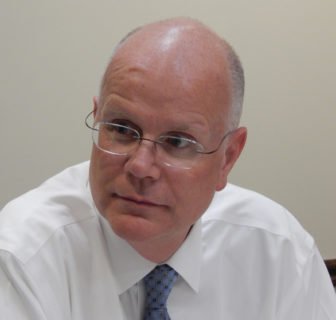CT’s Budget Reserve on the Brink of Hitting Unprecedented High

Audio By Carbonatix

Connecticut State Capitol. Photo credit: Ronni Newton (we-ha.com file photo)
The state is projected to have more than $2.3 billion in reserve when an audit is completed in September.
By Keith M. Phaneuf, CTMirror.org

Kevin Lembo. CTMirror.org
The last time state government filled its piggy bank to the limit wasn’t exactly a shining moment in Connecticut budget history.
The savings limit was relatively easy to hit and offered only a meager buffer against even a modest recession.
And once the rainy day fund was full, officials ignored cash-starved pension programs – at great cost to future taxpayers – and instead doled out hundreds of millions of dollars in rebates to voters.
That was nearly 20 years ago. Now Connecticut is again nearing a limit on its reserves. But things are very different in 2019.
By the end of the new budget cycle, the state could have a reserve three times the size of the cushion it built in the early 2000s.
And if projections hold over this fiscal year and next, Gov. Ned Lamont and the General Assembly could begin accelerating payments on Connecticut’s massive pension debt.
“Re-election is important to people, being able to go back home and say ‘See what I did?’” said Sen. John Fonfara, D-Hartford, co-chairman of the Finance Committee and one of the chief architects of the enhanced savings program developed in recent years. But for too many years, what governors and legislator “did” often involved expanding or creating new programs – even if the revenue growth paying for them might not last that long.
Fiscal stability was sacrificed to the next state election cycle, which comes every two years.
“I’m grateful to my colleagues in this session for remaining disciplined, because it has paid dividends and will continue paying dividends,” Fonfara said.
“If our state can keep to this promise, and maintain financial discipline, then Connecticut could be on the verge of a new day of fiscal stability and public trust,” said Comptroller Kevin P. Lembo, who also helped develop new savings initiatives.
Lembo, and Lamont’s administration, project Connecticut will have more than $2.3 billion in reserve when the audit of the just-completed 2018-19 fiscal year is done in late September.
This easily shatters the previous records of the $1.37 billion the state held as late as June 2009.
More importantly, the $2.3 billion represents 12 percent of annual operating expenses, topping the 8 percent mark also set in 2009.
But it could get even better.
Projections from the legislature’s nonpartisan Office of Fiscal Analysis show Connecticut could add $930 million more to the reserve over this fiscal year and next combined.
And by the end of summer 2021, the state could have $3.26 billion in the bank.
If that happens, Connecticut would have to spend some of it. The most the reserve can hold is 15 percent of operating costs, which would be about $3 billion.
But don’t look for the other $260 million to come back as $50-per-person tax rebates. Connecticut would be required to pour the rest into its pension funds, which have tens of billions of dollars in unfunded liabilities.
Lembo has argued since he took office in 2011 that Connecticut needs a reserve of at least 15 percent due to the unusual nature of the state income tax – which pays for slightly more than half of all General Fund expenses.
In May 2002, when Connecticut last filled its rainy day fund to the max, the savings limit was just 5 percent of annual operating expenses. (Note: The $595 million socked away by Gov. John G. Rowland and the legislature was wiped out entirely that same month to help close an $815 million budget deficit.)
Unlike many other states, nearly one-third of Connecticut’s income tax receipts come not from paycheck withholdings but from quarterly tax filings. And those quarterly returns are dominated by capital gains, dividends and other investment-related earnings.
Those receipts often grow by double-digit percentages during good economic times – and plunge in the same fashion during a recession.
Legislators from both parties agreed two years ago to make three huge changes. First, they instituted a “volatility cap,” which requires the state to save income tax receipts from quarterly filings after they exceed a threshold level.
Second, legislators and governors no longer can adopt a budget with nearly equal spending and revenues. Now they must design the budget to run – at least on paper – in surplus of just under 1 percent.
These first two initiatives are designed to force the state to save for the next recession, when income tax receipts may plummet. The final initiative says the rainy day fund can hold an amount equal to 15 percent of operating expenses, but anything beyond that the must be spent paying down debt.
Lamont, who inherited this system when he took office in January, insisted that legislators maintain it and look to grow reserves further.
“This will allow us to best position the state for the next generation of economic growth as we demonstrate the fiscal prudence and willingness to tackle the long term obligations that have impeded us for decades,” Chris McClure, spokesman for the governor’s budget office, said of the swelling reserves. “It is truly a credit to the proponents of the [volatility] cap and the state’s adherence to it during this period of strong economic performance that we are able to move forward so quickly.”
And while paying down pension debt is important, Fonfara said households and businesses might most appreciate the stability the reserve provides – especially when the next recession arrives.
“In the past we would get trapped in a spiral: Little or no reserve means raising taxes and cutting services. Both of those have an impact on the long-term of the fiscal health of our state and the quality of life,” Fonfara said, adding that a larger reserve means less budgetary pain during the worst economic times. “This way we can still make investments in our state.”
Reprinted with permission of The Connecticut Mirror. The author can be reached at [email protected].
Like what you see here? Click here to subscribe to We-Ha’s newsletter so you’ll always be in the know about what’s happening in West Hartford!



